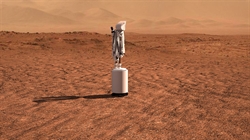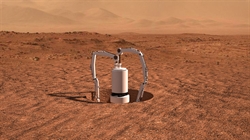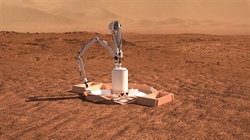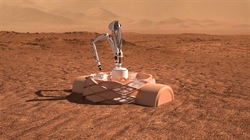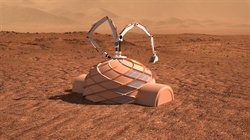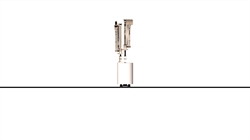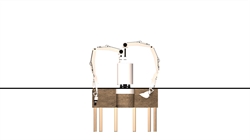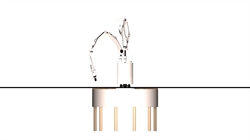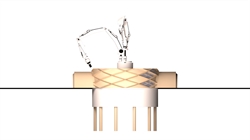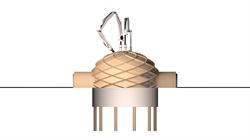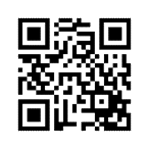Project : Refuge
As a design and built team we want to propose a performant design in term of constructability, comfort and space, but we also want that new Martian explorer feel like at home in the “Refuge”. This Habitat will be the center, the safest place on mars for this news habitants. This goal leads us to propose this project to meet the challenge.
1. Architectural and design concept
2. Constructability principle
3. Living concept
Future Developments
Our 3D printed habitat can be considered as a simple start in Mars exploration and colonization. To confront this challenge, the small habitat can be replicated in greater numbers in order to build small villages. Foraging for water will remain another challenge.
The Habitat can also be considered as a small autonomous terraforming unit, releasing internal CO2 production and some CO2 production plant around the habitat. The habitat can deploy a sort of magnetic umbrella in order to contain the gas around it. This might permit the development of small ecosystems. This shelter will be the first step of humanity on Mars.
That’s one small habitation for a man, one new home for mankind.
As a design and built team we want to propose a performant design in term of constructability, comfort and space, but we also want that new Martian explorer feel like at home in the “Refuge”. This Habitat will be the center, the safest place on mars for this news habitants. This goal leads us to propose this project to meet the challenge.
1. Architectural and design concept
1.1 Site choiceThe Korolev Crater’s site was chosen for its accessibility, the raw materials available, the security of the location, and possible presence of underground frozen water.
1.2 Design
The interior and exterior design are constrained by the structure and the methodology of 3D printing however, these limits became an inspiration for the design. Because the shelter will be printed on site, there is flexibility in design and optimization, therefore the parametric design can fluctuate in accordance with data collected by probes that will be processed by AI. The characteristics of the structural design are the center of the project. The central bearing element where the 3D printer is anchored, or “the tree”, supports and protects the shelter and its occupants.
1.3 VisionThe windows are an essential part of the design. Apart from bringing natural light into the habitat, windows reduce feelings of isolation and depression by offering a connection to the outside world.1.4 Access and safetyTwo big airlock chambers allow the inhabitants to access the shelter securely and with ease. The additional chamber was added as an alternative exit, in case of emergency. Aside from their practical use, these chambers provide a calm, tranquil welcoming to the explorers – in attempt to make them feel at home.1.5 Space optimizationThe chosen excavation technique allows us to gain important naturally insulated underground space.The space will be optimized on every level of the habitat, individually, in order to take full advantage of the qualities of each space. Data obtained by probes and processed by the AI of our parametric design will optimally orient the habitat. For example, the openings and space layout will be conditioned intimately by local environmental factors.1.6 Space repartitionSpace has been allotted according to the physiological and emotional needs of the explorers. Avoiding feelings of confinement and claustrophobia were motivating factors when considering space repartition.Leisure areas include a bar with various games and a sports room equipped with facilities that take into account Mars’s low gravity. Water facilities are designed on top of each other to optimize pipe and duct routes. Hydroponic greenhouse farming facilities will be available.
2. Constructability principle
2.1 3d Printing concept + Methods conceptThe excavation of raw material for 3D Printing allows us to build up the structure, in doing so we can optimize available space and reinforce the implantation of the habitat on site.The robot must be extremely reliable and robust, it will be used as an excavator and 3D printer. It will have 2 heads (each of them has 1 printer head and 1 excavation head), 2 arms, stabilization tools, foraging tools, and a furnace. The robot may also need blow and suction pipes. The heads on the printers must be interchangeable.The printer will be used to cover parts of the habitat with soil to improve insulation and act as a wind barrier.Keeping the objective to bring minimal materials in mind, all furniture (bed, bench, kitchen…) will be printed along with the rest of the habitat. Some needs, such as airlock doors, will have to be imported.2.2 AI conception and realization and learningThe AI Parametric Design is a major part of the project and is imperative to the success of such an enterprise. The goal of our AI is to adapt the design according to the constraints, issues, mechanical and physical characteristics of the raw materials on site and the challenges facing construction. The information will be processed by the AI in order to select the best location, best orientation, best structural framing, density, and overall nature of the foundation. After the construction the AI will be used as home facility manager by up-keeping the habitat and providing comfort for its habitants.2.3 Structure, protectionThe parametric structure calculated by AI considers all parameters encountered on Mars (quality and composition of the raw material, site, wind , foundation …) in order to achieve optimal performance and durability while using minimal energy and resources.2.4 InsulationThe insulation is primarily provided by Martian soil which will cover the shelter as needed. The structure will protect explorers from radiation and will be used as thermal insulation.The complexity of the structure implies an empty space which will be used as an insulator from cold and various temperatures on Mars. Beneath the skin, or the outermost layer, there is an intentional space intended to act as an additional layer of insulation. On Earth it is proven that “air” is the best insulation.2.5 Auto repairThe printer will stay in place and will be use to prevent and repair all eventual damage to the habitat.2.6 Energy productionRenewable energy options should be explored first. A small wind farm built close to the habitat would generate more than enough energy. In addition to energy harnessed from the wind, the exterior wall and windows can be equipped with solar panels. Provided that wind-solar energy is not adequate, nuclear fusion could act as a primary energy source.
3. Living concept
3.1 Well beingQuality of life is among the most important aspects of the first Martian mission. Residents should feel comfortable and at home. After their long journey, and days of exploration, explorers must be able to recover peacefully in their dwelling.We foresee the importance of a shared common space. Whether it be to exchange thoughts and ideas, share a meal, or exercise. With this in mind there will be multiple, shared, facilities to encourage community and improve quality of life. The spaces are placed intentionally with favorability regarding the act or activity.The sub-level of the refuge is compartmentalized in order to allot appropriate space for working, research and agricultural experiments.3.2 Personal Space and DevelopmentSleeping quarters are an intimate space where individuals can meet with one another, communicate back to Earth with their loved ones, or simply find solitude. These spaces are completely personal and may be utilized however seen fit by its’ inhabitant.Personal spaces are located above the ground floor and have wide openings on their sloped ceilings offering a stunning view of Martian starry nights and allowing the inhabitants to be waken up by natural light.Well being is a key element for the success of such an adventure and those personal spaces were at the heart of our intentions during the overall design process.contact will create a bond between the explorers and their new environment.3.4 Virtual reality and communityIn order to escape feelings of isolation and abandonment a virtual immersion facility will be available to the inhabitants. This equipment will allow individuals to return to the familiarity of Earth and participate in an augmented reality.Complete immersion simulates familiar and comforting situations. It can also portray a more social and exciting environment, such as a bar or music venue.3.5 Wide Open VisionThe presence of windows will provoke a sensation of freedom and will permit Martian explorers to let his or her spirit wander across Mars while in total safety of the shelter. This permanent visual contact will create a bond between the explorers and their new environment.
Future Developments
Our 3D printed habitat can be considered as a simple start in Mars exploration and colonization. To confront this challenge, the small habitat can be replicated in greater numbers in order to build small villages. Foraging for water will remain another challenge.
The Habitat can also be considered as a small autonomous terraforming unit, releasing internal CO2 production and some CO2 production plant around the habitat. The habitat can deploy a sort of magnetic umbrella in order to contain the gas around it. This might permit the development of small ecosystems. This shelter will be the first step of humanity on Mars.
That’s one small habitation for a man, one new home for mankind.
PRESENTATION


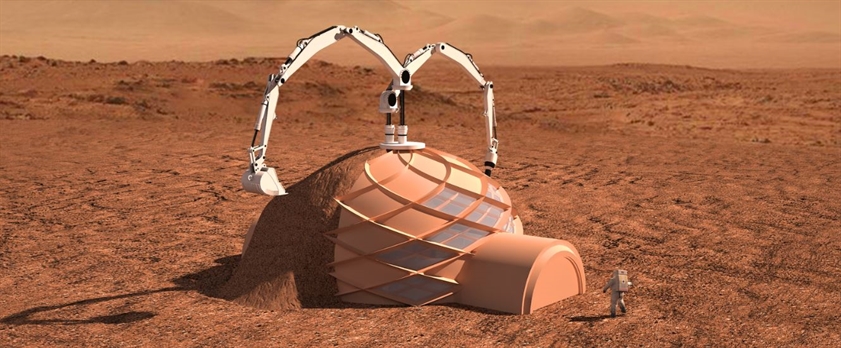
PLANS - SECTIONS


VISUAL RENDERINGS



STRUCTURAL DESIGN




ROBOT
